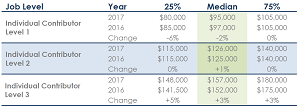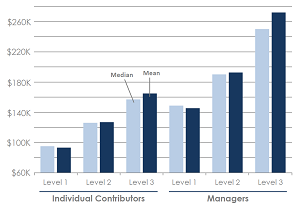News
Supply of More 'Junior' Data Scientists Levels Off Salaries, Says Recruiter
- By David Ramel
- June 8, 2017
Four the first time in four years of tracking, a recruiter has noticed a decrease in salaries for early-career data scientists -- a position once dubbed the "sexiest job of the 21st century" -- caused by more junior-level entrants into the field and other factors.
That information was a key takeaway in the newly published "The Burtch Works Study: Salaries of Data Scientists May 2017" from recruiter Burtch Works LLC.
Before this, data scientist salaries were seemingly in a perpetual climb, as the age of Big Data and mission-critical predictive analytics awarded those with hard-to-find advanced math, science and data skills special status in the IT and software development fields.
Not that it's all bad: Data scientist salaries are still sky high and still exceed those of other predictive analytics professionals, with higher-level individual contributors getting median base salaries of $157,000, while those junior-level data scientists garner $95,000. For managers, such salaries start at $148,750 at the low end of experience and $250,000 at level 3, the highest. (Burtch Works classifies its levels according to responsibilities and experience, with level 1 workers defined as typically having 0 to 3 years of experience, level 2 having 4-8 years and level 3 having 9-plus.)
These still-stellar salaries reflect the exalted status of data scientists, which prompted Harvard Business Review to deem the position "the sexiest job of the 21st century" in a 2012 article.
 [Click on image for larger view.]
Change in Base Salaries of Data Science Individual Contributors by Job Level (source: Burtch Works LLC)
[Click on image for larger view.]
Change in Base Salaries of Data Science Individual Contributors by Job Level (source: Burtch Works LLC)
However, all these salary levels have leveled off somewhat -- mirroring the findings of last year's report -- and the first-time decrease in data scientist salaries at any level is big news.
"For the first time in four years, salaries amongst individual contributor data scientists with 0-3 years' experience decreased slightly," the report said. "This is a marked difference because in every other year of our reports, these professionals were seeing the largest percentage gains in median base salaries. Salary increases have also begun to tail off for data scientists at other career levels."
In addition to the influx of junior data scientists, this leveling off -- all career levels experienced single-digit percentage changes compared to 2016 -- is also caused by other factors, the report said. These include: more data scientist candidates foregoing PhD's in favor of Master's degrees in order to enter the lucrative data science field sooner; and a blending of traditional predictive analytics professionals and data scientists.
 [Click on image for larger view.]
Median and Mean Base Salaries of Data Scientists by Job Category (source: Burtch Works LLC)
[Click on image for larger view.]
Median and Mean Base Salaries of Data Scientists by Job Category (source: Burtch Works LLC)
"More traditional analytics professionals have been learning typical data science tools and developing the skills necessary to transition into data science roles," the report said. "Now, the fields have begun to blend even more, and we expect the amalgamating to continue as analytics professionals take advantage of MOOCs (massive open online courses), bootcamps, microdegrees, in-house training, and other programs to supplement their current skillsets."
Some data points lifted from the report include:
- More than 85 percent of all data scientists are eligible for bonus pay; for managers, more than 90 percent are eligible. The median bonuses received vary from $10,000 for level 1 individual contributors, up to $84,500 for level 3 managers.
- 90 percent of data scientists have an advanced degree: 49 percent hold a Master's degree, and 41 percent hold a PhD.
- 27 percent of data scientists hold a degree in statistics or mathematics, while 19 percent have an engineering degree, and an additional 19 percent hold a computer science degree.
- Most data scientists continue to be employed on the West Coast, accounting for 40 percent of data scientists. Another 28 percent of data scientists are found in the Northeast.
- In all job categories, the highest base salaries are paid on the West Coast.
- By far, technology companies continue to be the largest employers of data scientists. This year, 41 percent of data scientists are employed in the tech industry.
- This year, financial services organizations employ the second largest number of data scientists at 13 percent, overtaking the advertising and marketing services vertical for the first time.
- Across many job categories, data scientists employed by technology and gaming companies earn higher median base salaries than those employed in other industries. This may be the result of a higher proportion of tech industry employees living on the West Coast, compared to those working in other industries.
- 36 percent of data scientists are non-U.S. citizens with F-1/OPT, H-1B, or another visa, or permanent residency which allows them to work in the U.S., reflecting an increase from 31 percent reported last year.
- The proportion of foreign-born data scientists is significantly higher among level 1 individual contributors, where nearly half (49 percent) of data scientists are not U.S. citizens.
Here is how the company described its methodology: "This sample contains 412 of the nearly 3,000 data scientists with whom Burtch Works maintains contact. Burtch Works collected the data for this study during interviews conducted over the 12 months ending March 2017, which is the year immediately following the period of interviews for the 2016 study. Professionals were included in the sample only if (1) they satisfied Burtch Works' criteria for data scientists, and (2) Burtch Works obtained complete information about that individual's compensation, demographic, and job characteristics."
About the Author
David Ramel is an editor and writer at Converge 360.